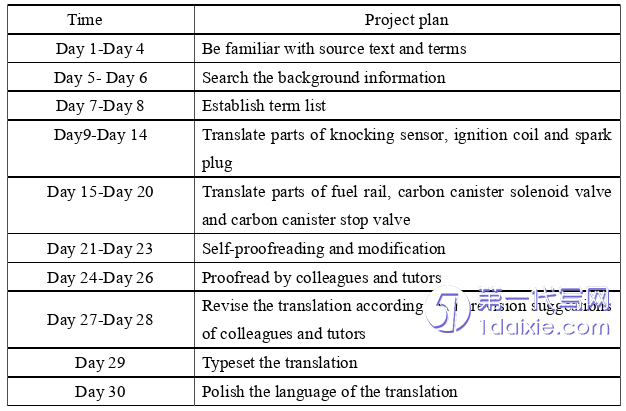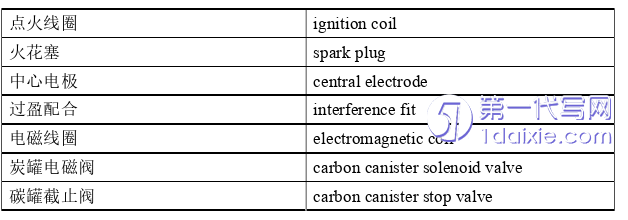本文是一篇英语毕业论文,本实践报告的材料节选自《某乘用车发动机控制系统维修手册》,介绍了爆震传感器、点火线圈、火花塞、燃油导轨、碳罐电磁阀、碳罐截止阀、压差传感器和制动真空压力传感器的维修注意事项,该翻译材料属于科技类文本。
1.Task Description
1.1 Background of the Project

Automobile industry, a pillar industry of China’s national economy, is of great significance to the development of China’s national economy. According to the data released by China Association of Automobile Manufactures on January 12, 2022, the export volume of China’s automobile was 2.015 million in 2021, which doubled year-on-year, accounting for 7.7% of the total automobile sales, an increase of 3.7 percentage points over the previous year. This is the first time that China’s automobile exports have exceeded 2 million. Besides, judging from the export volume of automobile enterprises in the whole year, the export volume of each month maintained a rapid growth year-on-year. According to these data, it can be predicted that this industry in China has great potential for development.
The author has worked as an intern in an automobile company for half a year, mainly engaged in the translation of automobile documents, such as maintenance manuals and quality inspection reports. The company has a huge overseas market and exports a large number of automobiles to overseas countries every year. With automobiles being exported to overseas countries, overseas dealers need English translations of these automobiles’ maintenance manuals and operation instructions. These English translations will help target readers better master relevant maintenance knowledge, so as to reduce mistakes in the maintenance process. Thus, the translator will strive to accurately translate this maintenance manual to meet their needs. The translator obtained this translation material from his internship company. During the internship, the author has done a lot of translation work on automobile maintenance manuals for various models.
1.2 Significance of the Project
The significance of this translation project will be discussed below. Firstly, the translation text can meet the needs of relevant personnel in the automotive industry. As mentioned above, overseas dealers have a demand for the English translations of those imported automobiles’ maintenance manuals. With English translations, the overseas dealers can carry out the maintenance services and reduce some operational risks.
Secondly, the practice project can provide a reference for other translators to translate scientific and technological texts. Guided by the selected theory, the translator strives to improve the quality of translation by using some translation skills, which will enable readers to gain some experience in translating similar texts.
Thirdly, this practice project is a valuable opportunity to improve the translator’s translation ability. The translator has to do a lot of work to translate this text. The translator has to master some knowledge in the field of automobile maintenance, learn a large number of professional terms in maintenance manuals and deeply understand the selected theory. At the same time, the author is given a chance to apply the translation techniques he learned in class to this translation work. Hence, this is an opportunity for the translator to improve his translation ability.
2. Translation Process
2.1 Pre-translation
2.1.1 Analysis of the Source Text
C-E or E-C translation is a complex cognitive process (Wang, 2015). Before translating, it is necessary for the translator to understand the source text deeply, which is a crucial step in doing translation work. If not, the translation will be full of omissions and mistranslations because the translator cannot understand the deep meaning of the source text.
First, the translator should collect as much background information as possible about the original text. Translators should be able to choose and create appropriate information (Nord, 2014). In order to find background information, the translator can refer to the parallel texts of maintenance manual of the company’s passenger vehicle in previous years. Only when the translator knows the background information can he have a deep understanding of the source text and finally get a better translation.
Second, the translator should determine the correct translations of the engine parts. These engine parts are professional terms in the source text, which may have several translations. Fortunately, the company where the author works has set up a terminology translation system (a system contains a number of terms in the automotive field and provides English translations of these terms) where the translator can find the correct translations of most engine parts.
Third, the translator should know the characteristics of scientific and technological texts. After reading the source text, the translator found that the source text has many professional terms about engine parts, a lot of long sentences with several verbs and a number of non-subject sentences. As scientific and technological articles are generally characterized by strictness, complex argumentation and strong logicality, translators should make the style and characteristics of the target language consistent with the original text in the process of translation (Yuan, 2021). Therefore, the translator should consider how to get a translation which is consistent with the meaning of the source text and conforms to the characteristics of EST.
2.2 While-translation
2.2.1 Comprehension of Source Text
The translation material used in this translation practice report belongs to scientific and technological text, which has a great number of non-subject sentences, professional terms and long sentences. The translator should focus on how to translate these terms correctly, how to understand and divide these long sentences and how to deal with these non-subject sentences. The translator should fully understand the key and difficult points in the original text before translating. When encountering difficult points in the original text, the translator can search on the Internet first. For example, the term “interference fit” in the original text refers to the use of the elasticity of the material to expand and deform the hole so as to fasten it on the shaft. When the hole is restored, it will produce a hooping force on the shaft to connect the two parts. For such terms, the translator can find the translation through the Internet, which can provide the translator with a correct translation and some explanatory words to help him understand.
2.2.2 Expression of Target Text
After analyzing and understanding the original text, the translator finally needs to get the expression of target text, which is the purpose of all preparations in translation. The translator realized that this maintenance manual belongs to scientific and technological text, which should first be faithful to the original text. Because the material contains a lot of operation knowledge, it may put the technical maintenance personnel in danger if the translation is full of mistranslations. Thus, the translator should exert himself to make the translation as faithful as possible to the original text, so as to translate each operation step accurately.

3. Translation Shifts Theory ..................................... 11
3.1 Brief Introduction of Translation Shifts Theory .............................. 11
3.1.1 Level Shifts .......................................... 11
3.1.2 Category Shifts ......................................... 11
4. Case Study ......................................... 15
4.1 Level Shifts ............................................ 15
4.1.1 Shifts of Tense and Aspect ............................................. 15
4.1.2 Shifts of Singular and Plural Expressions ..................... 17
5. Conclusion ................................... 29
5.1 Major Findings ........................................... 29
5.2 Limitations and Suggestions .................................... 30
4. Case Study
4.1 Level Shifts
Catford defined level shifts as “a source language item at one linguistic level has a target language translation equivalent at a different level” (Catford, 1965). Level refers to graphology, grammar, lexis and phonology, which can be shifted to each other theoretically. However, only shifts between lexis and grammar are possible when translating. In this translation, level shifts mainly include shifts of tense and aspect and shifts of singular and plural expressions, which refer to shifting from lexis to grammar.
4.1.1 Shifts of Tense and Aspect
The English language has the changes of tense, which includes future tense, present tense and past tense. English also has the changes of aspect, which includes perfect aspect and progressive aspect. English adds “-ing” at the end of verbs to indicate an on-going action; “Has / have done” is used to form the present perfect tense, which is used to indicate that the past action or state continues to the present; English uses past tense of verb like past tense “did” of the verb “do” to indicate the past tense, which expresses what happened in the past. Tense and aspect in English belong to the grammatical level. The Chinese language, however, has no corresponding grammatical category. Some adverbs and function words in Chinese can implicitly express the changes of tense and aspect. The Chinese language uses words like “正” and “着” to express the on-going action and uses words like “了”, “已经” and “过” to indicate the past tense. When translating Chinese into English, level shifts will occur when the translator shifts the words at the lexical level in Chinese to the tense and aspect at the grammatical level in English. The following are several examples to illustrate shifts of tense and aspect.
5. Conclusion
5.1 Major Findings
In terms of category shifts, the translator found that structural shifts, class shifts and unit shifts are beneficial to translation. Firstly, the English language and the Chinese language have differences in syntactic structure. The Chinese language uses active voice and prepositive attributives frequently, while the English language tends to use passive voice and postpositive attributives. The structural shifts in category shifts can guide the translator to shift from active voice to passive voice and shift from prepositive attributives to postpositive attributives when translating Chinese into English. Secondly, in terms of lexis, the Chinese language always uses verbs in sentences, while the English language uses nouns more commonly. Thus, the class shifts in category shifts have good guidance for translating Chinese into English. The author realized that the source text contains a number of verbs that describe the installation procedures of the engine parts. When translating, these verbs can be shifted to static expressions under the guidance of class shifts. Thirdly, the English language has a lot of long sentences, while the Chinese language uses a number of short sentences. The sentence groups in Chinese can be shifted to sentences in English under the guidance of unit shifts in category shifts. Thus, the loose structure of the Chinese sentences will be more compact and logical when using unit shifts. All in all, through these shifts, the quality of the translation can be greatly improved.
reference(omitted)
